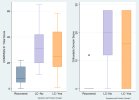Case-control study of autonomic symptoms in the setting of Long COVID with tilt table testing
BACKGROUND
Autonomic symptoms and orthostatic syndromes have been reported in Long COVID, but few studies have characterized findings using head up tilt table testing.
OBJECTIVE
To characterize autonomic responses to positional changes among individuals with Long COVID.
METHODS
We assessed autonomic symptoms using the Composite Autonomic Symptom Scale 31 (COMPASS 31) instrument and performed head up tilt table testing for 30 minutes at 70 degrees among individuals with Long COVID and recovered comparators.
RESULTS
We included 26 participants (median age 56 years, 50% female median 25 months after first COVID): 16 with Long COVID and 10 recovered comparators. COMPASS 31 scores (0–100, higher is worse) were higher among those with Long COVID (median 30.5 vs 8, p = 0.003). Heart rate was 8 beats per minutes higher throughout tilt among those with Long COVID (95% CI 1.1 to 14.4; p = 0.02); there were no differences in blood pressure. Ten (63%) with Long COVID had symptoms during tilt compared to none among recovered participants (p = 0.003). Three (19%) with Long COVID had clinically abnormal findings: one each with orthostatic hypotension, and delayed orthostatic hypotension, and cardioinhibitory/vasovagal presyncope.
CONCLUSIONS
Among those with chronic autonomic symptoms in the setting of Long COVID, symptoms were common during tilt testing, and heart rate was increased, but most did not meet diagnostic criteria for a clinically abnormal hemodynamic response. Further research into mechanisms of autonomic symptoms in Long COVID is urgently needed.
Web | PDF | PLOS ONE | Open Access
Matthew S Durstenfeld; Nirosh Mataraarachchi; Michael J Peluso; Marta Levkova-Clark; Veronica Schaffer; Emily A Fehrman; Grace Anderson; Diana Flores; Timothy J Henrich; Carlin S Long; Steven G Deeks; Priscilla Y Hsue
BACKGROUND
Autonomic symptoms and orthostatic syndromes have been reported in Long COVID, but few studies have characterized findings using head up tilt table testing.
OBJECTIVE
To characterize autonomic responses to positional changes among individuals with Long COVID.
METHODS
We assessed autonomic symptoms using the Composite Autonomic Symptom Scale 31 (COMPASS 31) instrument and performed head up tilt table testing for 30 minutes at 70 degrees among individuals with Long COVID and recovered comparators.
RESULTS
We included 26 participants (median age 56 years, 50% female median 25 months after first COVID): 16 with Long COVID and 10 recovered comparators. COMPASS 31 scores (0–100, higher is worse) were higher among those with Long COVID (median 30.5 vs 8, p = 0.003). Heart rate was 8 beats per minutes higher throughout tilt among those with Long COVID (95% CI 1.1 to 14.4; p = 0.02); there were no differences in blood pressure. Ten (63%) with Long COVID had symptoms during tilt compared to none among recovered participants (p = 0.003). Three (19%) with Long COVID had clinically abnormal findings: one each with orthostatic hypotension, and delayed orthostatic hypotension, and cardioinhibitory/vasovagal presyncope.
CONCLUSIONS
Among those with chronic autonomic symptoms in the setting of Long COVID, symptoms were common during tilt testing, and heart rate was increased, but most did not meet diagnostic criteria for a clinically abnormal hemodynamic response. Further research into mechanisms of autonomic symptoms in Long COVID is urgently needed.
Web | PDF | PLOS ONE | Open Access

